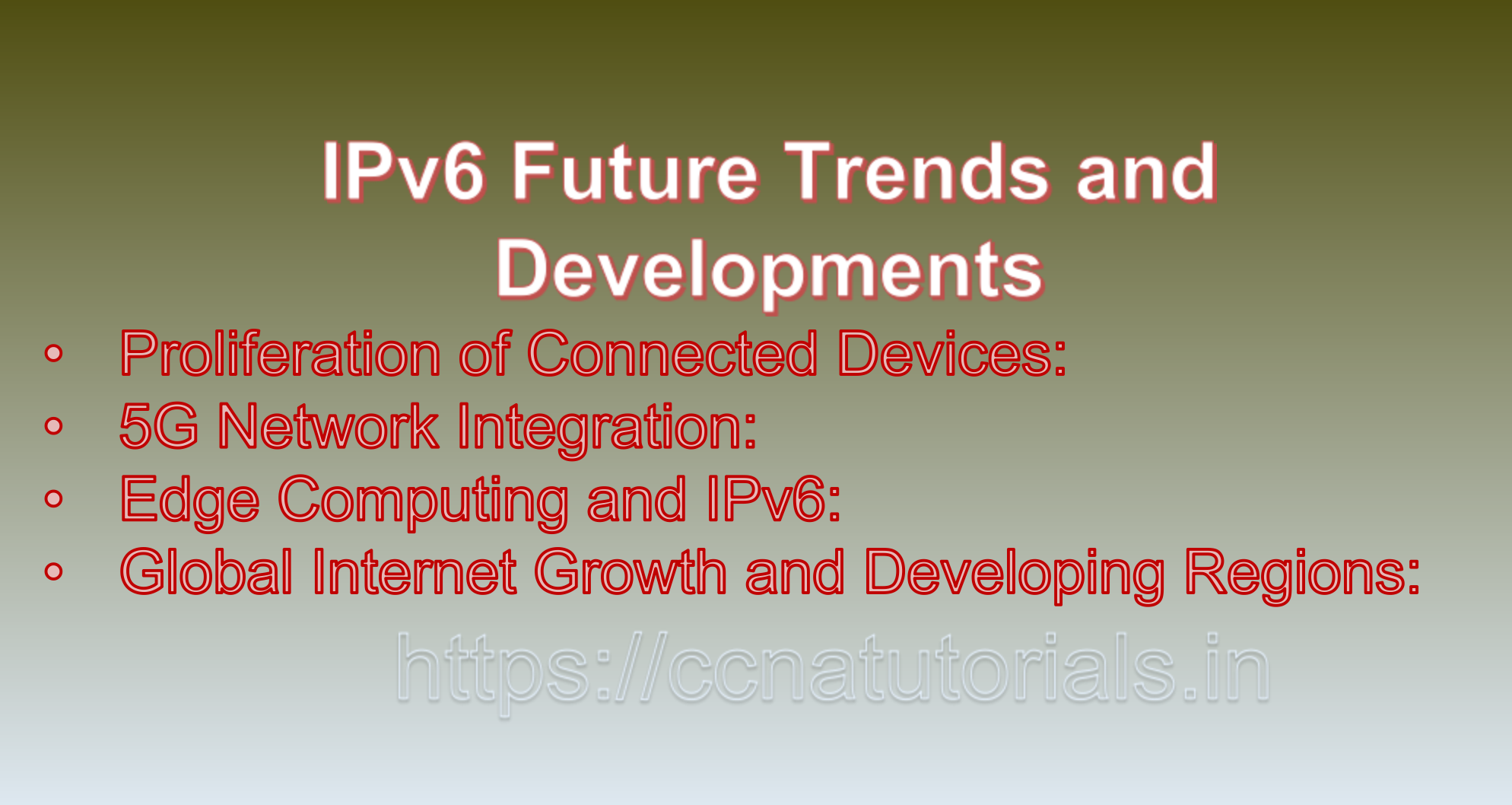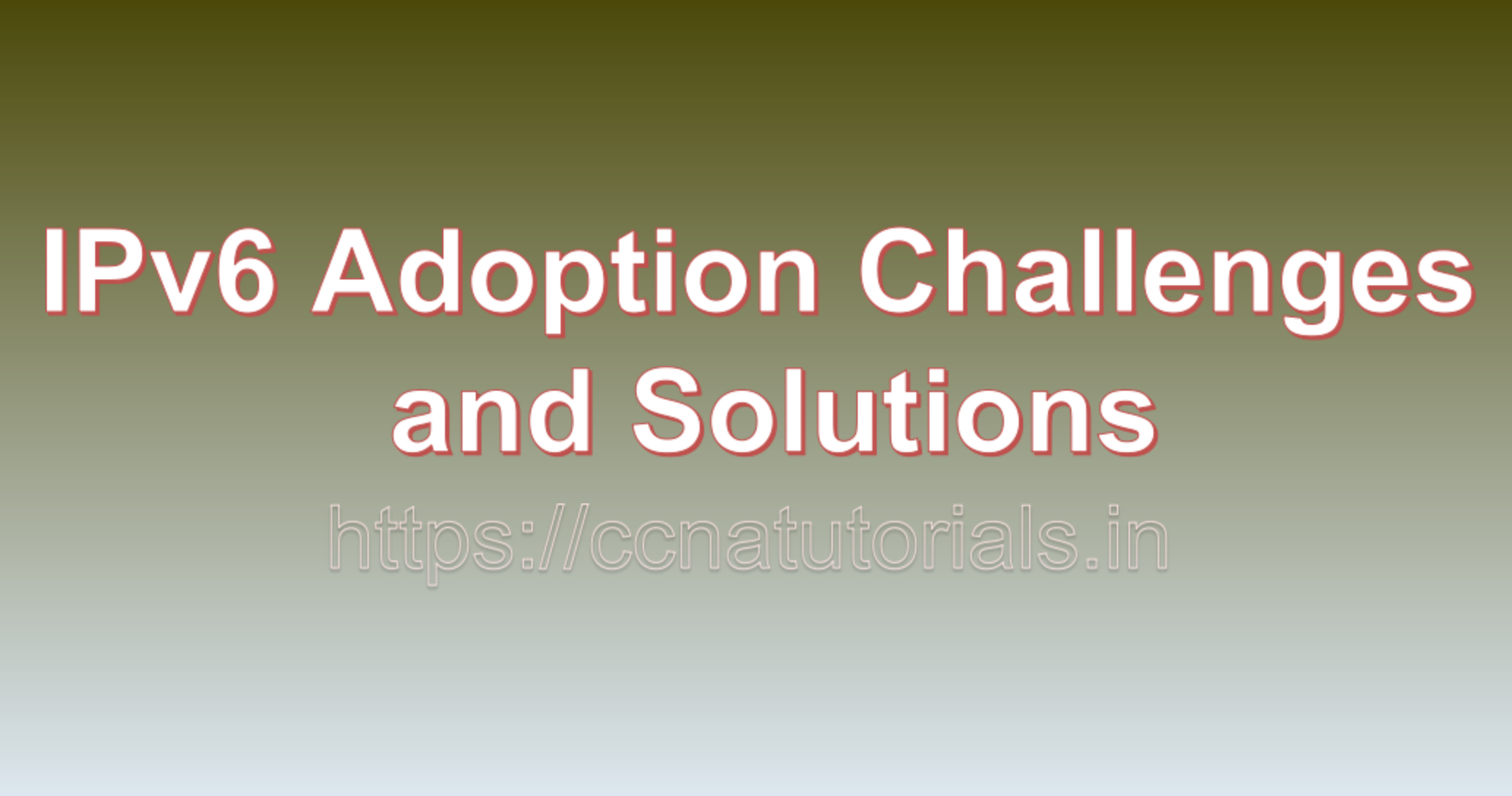Contents of this article
In this article, I describe IPv6 Future Trends and Developments: Paving the Path for a Connected Tomorrow. Internet Protocol version 6 (IPv6) represents the next phase of internet evolution, addressing the limitations of its predecessor, IPv4, and catering to the growing demands of a digitally connected world. As IPv6 adoption gains momentum, several trends and developments are shaping its future trajectory. From the proliferation of connected devices to the emergence of new technologies and services, IPv6 is at the forefront of the internet’s evolution. This article explores the future trends and developments of IPv6, highlighting their significance and providing examples of how these trends are shaping the digital landscape.
1. Proliferation of Connected Devices:
As the Internet of Things (IoT) becomes more pervasive, the number of connected devices is expected to explode. IPv6’s extensive address space is a fundamental enabler of this trend, allowing each device to have a unique address. For example, smart homes equipped with IPv6-enabled devices like thermostats, cameras, and appliances can seamlessly communicate and enhance user experiences.
2. 5G Network Integration:
The rollout of 5G networks promises ultra-fast speeds and low latency, opening doors to new applications such as augmented reality, virtual reality, and real-time data exchange. IPv6 is well-suited to accommodate the addressing requirements of the vast number of devices and sensors in 5G networks. For instance, autonomous vehicles powered by 5G networks can rely on IPv6 for efficient communication, contributing to safer and more efficient transportation systems.
3. Edge Computing and IPv6:
Edge computing brings computation closer to data sources, reducing latency and enhancing real-time processing. IPv6’s ability to assign unique addresses to a multitude of edge devices is essential for efficient communication. An example is the use of IPv6 in industrial IoT scenarios, where sensors at the edge communicate directly using IPv6 addresses, minimizing delays in data processing.
4. IPv6 and Cloud Services:
As cloud services become central to modern computing, IPv6 plays a crucial role in ensuring seamless connectivity between users and cloud resources. IPv6’s efficient routing and addressing capabilities support the demands of scalable and dynamic cloud environments. Cloud-native applications can leverage IPv6 for optimized communication, enhancing performance and user experiences.
5. Global Internet Growth and Developing Regions:
IPv6’s extensive address space is pivotal for accommodating the internet’s continued growth, especially in regions where internet adoption is expanding rapidly. For example, developing countries with large populations can leverage IPv6 to connect more citizens, bridge the digital divide, and enable economic growth through online services.
6. IPv6 in Critical Infrastructure:
Critical infrastructure sectors like energy, healthcare, and transportation are embracing IPv6 to enhance security, scalability, and efficiency. For instance, smart grids relying on IPv6 can optimize energy distribution and improve grid resilience through real-time monitoring and control.
7. Regulatory Mandates and IPv6 Adoption:
Governments and regulatory bodies are increasingly recognizing the importance of IPv6 in fostering a connected society. Some countries have introduced mandates or incentives to encourage IPv6 adoption. For instance, the Indian government’s “IPv6 Task Force” aims to promote IPv6 adoption and ensure India’s readiness for the future of the internet.
8. IPv6 and 6LoWPAN for Low-Power IoT:
IPv6 over Low-Power Wireless Personal Area Networks (6LoWPAN) is a protocol designed to enable IoT devices with limited power and resources to communicate over IPv6 networks. This trend is particularly relevant for applications like smart agriculture and environmental monitoring, where low-power sensors communicate using IPv6 for data collection and analysis.
9. IPv6 Security and Privacy Enhancements:
As IoT devices and networks grow, security and privacy become paramount concerns. IPv6 introduces features such as Secure Neighbor Discovery (SEND) and Internet Protocol Security (IPsec) to enhance security. For example, smart healthcare devices connected through IPv6 can ensure the confidentiality and integrity of patient data.
10. IPv6 for Enhanced Mobile and Remote Access:
IPv6’s efficient routing and addressing make it suitable for mobile and remote access technologies. Virtual Private Networks (VPNs) using IPv6 can provide secure and efficient connectivity for remote workers and mobile users, ensuring reliable access to corporate resources.
11. IPv6 and Smart Cities:
Smart city initiatives leverage IPv6’s scalability and address space to create interconnected urban environments. For instance, smart traffic management systems powered by IPv6 enable real-time traffic data collection and analysis, leading to optimized traffic flow and reduced congestion.
12. IPv6 and 6G:
While 5G networks are still in deployment, researchers are already exploring the possibilities of 6G. IPv6’s addressing capabilities are expected to play a crucial role in supporting the massive number of devices and connections envisioned for 6G networks, enabling new levels of connectivity and communication.
13. IPv6 in Satellite Communications:
Satellite communication systems are evolving to provide global connectivity, especially in remote and underserved areas. IPv6’s scalability and efficient routing are well-suited for satellite networks, ensuring reliable and seamless communication.

In short IPv6 Future Trends and Developments
The future of IPv6 is intertwined with the evolution of the internet itself. As new technologies, applications, and devices emerge, IPv6 remains a foundational component that enables seamless communication, scalability, and efficient data exchange. The trends and developments discussed in this article exemplify how IPv6 is shaping the digital landscape across various sectors. From IoT and 5G to edge computing and smart cities, IPv6’s role is pivotal in building a connected world that meets the demands of the future. As organizations, governments, and individuals continue to embrace these trends, IPv6 will continue to play a crucial role in shaping a more efficient, innovative, and interconnected global network.
IPv6 Future Trends and Developments: Shaping the Next Generation of Networking
As the internet ecosystem evolves, the adoption and integration of Internet Protocol version 6 (IPv6) continue to be central to its growth and sustainability. IPv6 addresses the limitations of the current addressing scheme, Internet Protocol version 4 (IPv4), by providing a larger address space, streamlined routing, and enhanced security features. In this rapidly changing landscape, several trends and developments are shaping the future of IPv6 adoption, networking practices, and the internet as a whole. This article explores these trends and developments in detail, along with real-world examples illustrating their impact.
1. Growing Demand for IP Addresses:
The explosive growth of connected devices, Internet of Things (IoT) deployments, and emerging technologies like 5G is driving the need for more IP addresses. IPv6’s expansive address space uniquely positions it to meet this demand.
– Example:
Smart Cities: Smart city initiatives involve deploying countless sensors and devices for urban management and infrastructure optimization. IPv6’s address space ensures that each device can have a unique IP address, facilitating seamless data exchange and intelligent decision-making.
2. IoT and IPv6 Synergy:
The IoT revolution relies on the ability to connect a wide range of devices to the internet. IPv6’s address abundance and autoconfiguration capabilities provide a robust foundation for IoT deployments.
– Example:
Industrial IoT: In industrial settings, IoT devices are used to monitor machinery, optimize processes, and enhance efficiency. IPv6’s scalability ensures that each sensor, machine, or controller can have a dedicated IP address, enabling real-time monitoring and control.
3. 5G and IPv6 Integration:
The rollout of 5G networks is poised to revolutionize connectivity with higher speeds and reduced latency. IPv6’s efficient routing aligns well with the demands of 5G networks.
– Example:
Augmented Reality (AR) Gaming: Multiplayer AR games rely on low-latency, high-bandwidth connections. 5G’s capabilities combined with IPv6’s optimized routing ensure smooth gameplay experiences, regardless of the players’ locations.
4. Security and Privacy Enhancements:
IPv6 introduces security features such as IPsec (Internet Protocol Security) as a fundamental part of its architecture. This addresses concerns related to data integrity, confidentiality, and authenticity.
– Example:
Remote Work: With remote work becoming a standard practice, secure communication is paramount. IPv6’s built-in IPsec can be leveraged to create secure virtual private networks (VPNs) for remote workers, protecting sensitive data during transmission.
5. Global Internet Governance:
The internet community’s efforts to promote IPv6 adoption are leading to greater cooperation among governments, organizations, and stakeholders worldwide. Governments are recognizing the importance of transitioning to IPv6 to ensure their countries remain connected and competitive.
– Example:
National IPv6 Task Forces: Many countries have established task forces or committees to promote IPv6 adoption. These bodies collaborate with ISPs, businesses, and academia to drive awareness and create roadmaps for IPv6 migration.
6. IPv6 in Cloud Computing:
Cloud computing continues to transform how businesses operate, and IPv6 plays a crucial role in optimizing the connectivity between cloud resources and end-users.
– Example:
Enterprise Cloud Migration: Enterprises are moving their applications and services to the cloud for scalability and cost-efficiency. IPv6 enables efficient communication between cloud-based servers and users’ devices, improving performance and reducing latency.
7. IPv6-Only Networks:
As IPv6 adoption matures, we can expect to see more IPv6-only network deployments. These networks eliminate the need for dual-stack configurations, streamlining network management.
– Example:
Greenfield Deployments: New infrastructure projects or data centers can take advantage of IPv6-only architectures from the start. This approach reduces complexity and optimizes resource utilization.
8. Education and Training Initiatives:
As IPv6 continues to gain traction, education and training initiatives play a pivotal role in equipping network engineers, administrators, and IT professionals with the skills needed for successful IPv6 deployment.
– Example:
Online Certification Programs: Organizations and institutions offer online courses and certification programs focused on IPv6. These programs empower professionals to become IPv6 experts, ensuring the availability of skilled individuals for seamless integration.
9. Integration of AI and IPv6:
The integration of artificial intelligence (AI) and machine learning with IPv6 networks opens up opportunities for predictive network management, automated security measures, and optimized traffic routing.
– Example:
Network Anomaly Detection: AI algorithms can analyze IPv6 traffic patterns and detect anomalies that may indicate security breaches or performance issues. This proactive approach enhances network security and reliability.
10. Global Collaboration for IPv6 Adoption:
The continued growth of the internet demands a collective effort from stakeholders to ensure a smooth transition to IPv6. Collaboration between ISPs, content providers, hardware manufacturers, and regulatory bodies is key.
– Example:
World IPv6 Launch: Events like World IPv6 Launch demonstrate the commitment of major websites, content providers, and ISPs to enable IPv6 on their services. This concerted effort raises awareness and drives adoption.
Conclusion for IPv6 Future Trends and Developments
The future of IPv6 is vibrant and promising, with trends and developments shaping the evolution of networking practices, connectivity, and the internet ecosystem. As the demand for IP addresses grows, the synergy with IoT, 5G, and cloud computing becomes more evident. The integration of security features, the push for global internet governance, and the emergence of IPv6-only networks highlight the transformative potential of IPv6 adoption. Education initiatives, AI integration, and collaborative efforts ensure a smooth transition to IPv6, positioning the internet for continued growth, innovation, and connectivity in the digital age.






